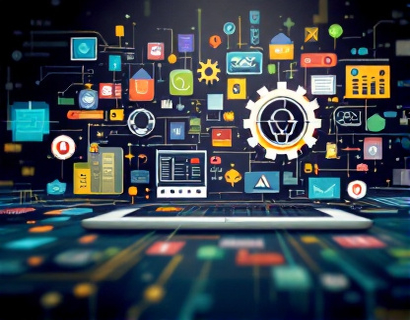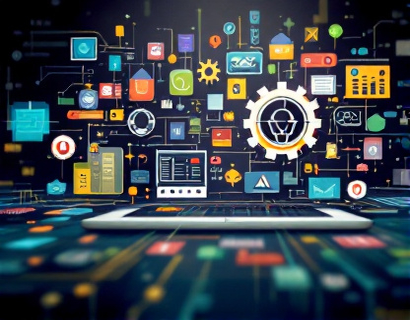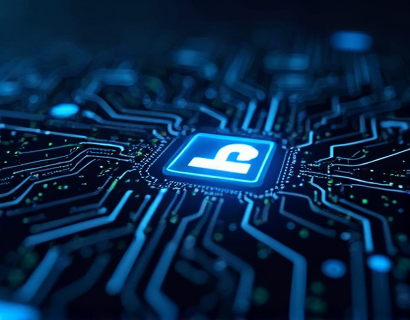Seamless AI and Blockchain Integration: An Essential Guide for Business Digital Transformation
The integration of Artificial Intelligence (AI) and blockchain technology represents a pivotal shift in the landscape of business operations. As companies strive to stay competitive in an increasingly digital world, understanding how to seamlessly integrate these technologies is crucial for successful digital transformation. This guide serves as an essential resource for business leaders aiming to harness the power of AI and blockchain to streamline operations, enhance security, and unlock new growth opportunities.
AI and blockchain, though distinct in their functionalities, complement each other in ways that can revolutionize business processes. AI, with its ability to analyze vast amounts of data and make intelligent decisions, paired with blockchain's inherent security and transparency, creates a powerful synergy. This integration can lead to more efficient, secure, and innovative business models. However, the journey to seamless integration is complex and requires a strategic approach.
Understanding AI and Blockchain
To effectively integrate AI and blockchain, it's essential to first understand the fundamentals of each technology.
AI refers to the simulation of human intelligence in machines that are programmed to think and learn like humans. These systems can process information, recognize patterns, and make decisions with minimal human intervention. AI encompasses various subfields, including machine learning, natural language processing, and computer vision.
Blockchain, on the other hand, is a decentralized digital ledger technology that records transactions across multiple computers in such a way that the registered transactions cannot be altered retroactively. This technology ensures transparency, security, and immutability, making it ideal for applications requiring trust and verification.
The combination of AI and blockchain can address some of the limitations of using these technologies in isolation. For instance, AI can enhance the efficiency of blockchain networks by optimizing consensus mechanisms and improving data processing, while blockchain can provide a secure and transparent environment for AI models to operate.
Benefits of AI and Blockchain Integration
The integration of AI and blockchain offers numerous benefits that can drive business transformation:
- Enhanced Security: Blockchain's cryptographic techniques and decentralized nature make it highly secure. When combined with AI, which can detect and respond to security threats in real-time, the overall security of business operations is significantly bolstered.
- Improved Efficiency:
- Data Integrity and Transparency:
- Innovative Business Models:
AI can automate and optimize various processes within a blockchain network, reducing manual interventions and increasing operational efficiency. For example, smart contracts can be enhanced with AI to execute more complex and dynamic business logic.
Blockchain ensures that data is tamper-proof and transparent, which is crucial for AI systems that rely on high-quality data for training and decision-making. This integrity helps build trust in AI-driven insights and predictions.
The synergy between AI and blockchain enables the creation of new business models, such as decentralized finance (DeFi) and tokenized assets, which can open up new revenue streams and market opportunities.
Challenges in AI and Blockchain Integration
Despite the potential benefits, integrating AI and blockchain comes with its own set of challenges:
- Technical Complexity:
- Scalability Issues:
- Regulatory Uncertainty:
- Data Privacy Concerns:
Both AI and blockchain are complex technologies that require specialized knowledge to implement effectively. The integration of these technologies demands a deep understanding of both domains, which can be a barrier for many organizations.
Blockchain networks, especially public ones, can face scalability issues due to their consensus mechanisms and data storage requirements. Integrating AI, which often requires significant computational power, can exacerbate these issues.
The regulatory landscape for both AI and blockchain is still evolving. Ensuring compliance with existing and future regulations while leveraging these technologies can be challenging and requires careful navigation.
While blockchain provides transparency, it can also raise privacy concerns, especially when sensitive data is involved. Integrating AI, which often requires large datasets, adds another layer of complexity in managing data privacy.
Strategies for Seamless Integration
To overcome the challenges and successfully integrate AI and blockchain, businesses can adopt the following strategies:
1. Build a Strong Technical Foundation
Invest in building a robust technical infrastructure that supports both AI and blockchain. This includes:
- Developing a skilled team or partnering with experts who have expertise in both AI and blockchain.
- Utilizing cloud-based solutions that offer scalable resources and flexibility for AI computations and blockchain deployments.
- Implementing robust data management practices to ensure data quality and compliance.
2. Start with Pilot Projects
Begin with small-scale pilot projects to test the integration of AI and blockchain in a controlled environment. This approach allows businesses to:
- Identify and address technical challenges early on.
- Gain insights and refine processes before scaling up.
- Demonstrate value and secure buy-in from stakeholders.
3. Focus on Data Quality and Governance
Ensure that the data used for AI models is of high quality and complies with privacy regulations. Implement data governance frameworks that define how data is collected, stored, and used in both AI and blockchain systems.
4. Leverage Hybrid Blockchain Models
Consider using hybrid blockchain models that combine public and private blockchains to balance transparency and privacy. This approach can help address data privacy concerns while maintaining the benefits of blockchain's immutability and security.
5. Stay Informed on Regulatory Developments
Monitor regulatory changes and engage with policymakers to shape the regulatory environment. This proactive approach can help businesses navigate compliance challenges and capitalize on regulatory opportunities.
Case Studies and Real-World Applications
Exploring real-world applications can provide valuable insights into the practical benefits and challenges of AI and blockchain integration:
One notable example is the use of AI and blockchain in supply chain management. Companies like IBM and Maersk have developed blockchain-based platforms that incorporate AI to enhance traceability, efficiency, and security in global supply chains. AI algorithms can predict supply chain disruptions and optimize routes, while blockchain ensures transparent and tamper-proof tracking of goods.
In the financial sector, DeFi platforms leverage AI and blockchain to offer decentralized lending and borrowing services. AI models can assess creditworthiness and automate loan processing, while blockchain ensures secure and transparent transactions.
These case studies demonstrate that when implemented correctly, the integration of AI and blockchain can lead to significant improvements in operational efficiency, security, and innovation.
Future Trends and Opportunities
The integration of AI and blockchain is an evolving field with numerous future trends and opportunities:
1. Increased Adoption: As businesses become more aware of the benefits, the adoption of AI and blockchain integration is expected to grow across various industries.
2. Advancements in Technology: Continuous advancements in AI and blockchain, such as more efficient consensus mechanisms and advanced machine learning algorithms, will enhance the feasibility and effectiveness of their integration.
3. Interoperability: Efforts to improve interoperability between different blockchain platforms and AI systems will facilitate broader and more seamless integrations.
4. Ethical AI and Blockchain: There will be a growing focus on developing ethical AI and blockchain solutions that prioritize transparency, fairness, and sustainability.
By staying ahead of these trends, businesses can position themselves to capitalize on emerging opportunities and maintain a competitive edge.
Conclusion
Integrating AI and blockchain represents a transformative journey for businesses looking to enhance their operations, security, and innovation capabilities. While the path to seamless integration is complex, the potential rewards are substantial. By understanding the fundamentals, addressing challenges, and adopting strategic approaches, businesses can successfully navigate this digital transformation. The future of business lies in harnessing the power of AI and blockchain, and those who lead the way will reap the benefits of a more efficient, secure, and innovative future.










































